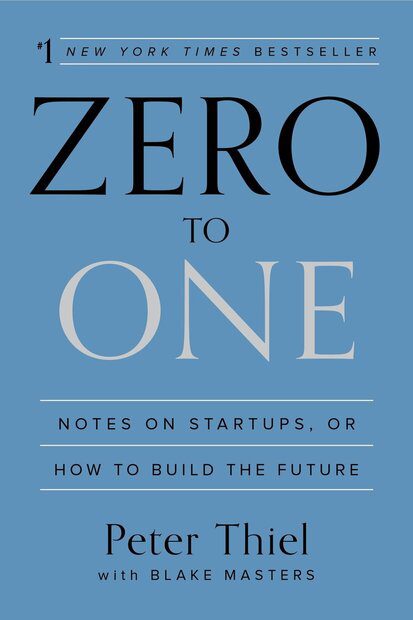Zero to One: Notes on Startups, or How to Build the Future is a 2014 book by the American entrepreneur and investor Peter Thiel co-written with Blake Masters. It is a condensed and updated version of a highly popular set of online notes taken by Masters for the CS183 class on startups, as taught by Thiel at Stanford University in Spring 2012.
The book is about the questions you must ask and answer to succeed in the business of doing what a startup has to do: question received ideas and rethink business from scratch.
You can’t escape the madness of crowds by dogmatically rejecting them. Instead ask yourself: how much of what you know about business is shaped by mistaken reactions to past mistakes? The most contrarian thing of all is not to oppose the crowd but to think for yourself.
Zero to One
Doing what we already know how to do takes the world from 1 to n, adding more of something familiar. But every time we create something new, we go from 0 to 1. The act of creation is singular, as is the moment of creation, and the result is something fresh and strange.
“Zero to One is about how to build companies that create new things.”
The paradox of teaching entrepreneurship is that such a formula necessarily cannot exist; because every innovation is new and unique, no authority can prescribe in concrete terms how to be innovative.
“Successful people find value in unexpected places, and they do this by thinking about business from first principles instead of formulas.”
The Future of Progress
When we think about the future, we hope for a future of progress. That progress can take one of two forms
Vertical or intensive progress means doing new things—going from 0 to 1. Vertical progress is harder to imagine because it requires doing something nobody else has ever done. If you take one typewriter and build 100, you have made horizontal progress. If you have a typewriter and build a word processor, you have made vertical progress.
At the macro level, the single word for horizontal progress is globalization—taking things that work somewhere and making them work everywhere. China is the paradigmatic example of globalization; its 20-year plan is to become like the United States is today.
STARTUP THINKING
“Startups operate on the principle that you need to work with other people to get stuff done, but you also need to stay small enough so that you actually can.”
Positively defined, a startup is the largest group of people you can convince of a plan to build a different future. A new company’s most important strength is new thinking: even more important than nimbleness, small size affords space to think.
The first step to thinking clearly is to question what we think we know about the past.
Lessons Learned from Dot-Com Bubble
The entrepreneurs who stuck with Silicon Valley learned four big lessons from the dot-com crash that still guide business thinking today:
1. Make incremental advances
Grand visions inflated the bubble, so they should not be indulged. Anyone who claims to be able to do something great is suspect, and anyone who wants to change the world should be more humble. Small, incremental steps are the only safe path forward.
2. Stay lean and flexible
All companies must be “lean,” which is code for “unplanned.” You should not know what your business will do; planning is arrogant and inflexible. Instead you should try things out, “iterate,” and treat entrepreneurship as agnostic experimentation.
3. Improve on the competition
Don’t try to create a new market prematurely. The only way to know you have a real business is to start with an already existing customer, so you should build your company by improving on recognizable products already offered by successful competitors.
4. Focus on product, not sales
If your product requires advertising or salespeople to sell it, it’s not good enough: technology is primarily about product development, not distribution. Bubble-era advertising was obviously wasteful, so the only sustainable growth is viral growth.
If you want to create and capture lasting value, don’t build an undifferentiated commodity business.
Competition vs Monopoly
In business, money is either an important thing or it is everything. Monopolists can afford to think about things other than making money; non-monopolists can’t. In perfect competition, a business is so focused on today’s margins that it can’t possibly plan for a long-term future. Only one thing can allow a business to transcend the daily brute struggle for survival: monopoly profits.
Competition is an ideology—the ideology—that pervades our society and distorts our thinking. We preach competition, internalize its necessity, and enact its commandments; and as a result, we trap ourselves within it—even though the more we compete, the less we gain.
“Winning is better than losing, but everybody loses when the war isn’t one worth fighting.”
Vanity Metrics
If you focus on near-term growth above all else, you miss the most important question you should be asking: will this business still be around a decade from now? Numbers alone won’t tell you the answer; instead you must think critically about the qualitative characteristics of your business.
CHARACTERISTICS OF MONOPOLY
Every monopoly is unique, but they usually share some combination of the following characteristics: proprietary technology, network effects, economies of scale, and branding.
1. Proprietary Technology
Proprietary technology is the most substantive advantage a company can have because it makes your product difficult or impossible to replicate.
2. Network Effects
Network effects make a product more useful as more people use it. For example, if all your friends are on Facebook, it makes sense for you to join Facebook, too. Unilaterally choosing a different social network would only make you an eccentric.
3. Economies of Scale
A monopoly business gets stronger as it gets bigger: the fixed costs of creating a product (engineering, management, office space) can be spread out over ever greater quantities of sales. Software startups can enjoy especially dramatic economies of scale because the marginal cost of producing another copy of the product is close to zero.
“A good startup should have the potential for great scale built into its first design”
4. Branding
A company has a monopoly on its own brand by definition, so creating a strong brand is a powerful way to claim a monopoly.
BUILDING A MONOPOLY
Brand, scale, network effects, and technology in some combination define a monopoly; but to get them to work, you need to choose your market carefully and expand deliberately.
Start Small and Monopolize
Every startup is small at the start. Every monopoly dominates a large share of its market. Therefore, every startup should start with a very small market. Always err on the side of starting too small. The reason is simple: it’s easier to dominate a small market than a large one. If you think your initial market might be too big, it almost certainly is.
Scaling Up
Once you create and dominate a niche market, then you should gradually expand into related and slightly broader markets.
“As you craft a plan to expand to adjacent markets, don’t disrupt: avoid competition as much as possible.”
Last Mover Advantage
You’ve probably heard about “first mover advantage”: if you’re the first entrant into a market, you can capture significant market share while competitors scramble to get started. But moving first is a tactic, not a goal. What really matters is generating cash flows in the future, so being the first mover doesn’t do you any good if someone else comes along and unseats you. It’s much better to be the last mover—that is, to make the last great development in a specific market and enjoy years or even decades of monopoly profits.
The way to do that is to dominate a small niche and scale up from there, toward your ambitious long-term vision. In this one particular at least, business is like chess.
To succeed, you must study the endgame before everything else. – Grandmaster José Raúl Capablanca
Optimistic vs Pessimistic
You can also expect the future to be either better or worse than the present. Optimists welcome the future; pessimists fear it. Combining these possibilities yields four views:
Indefinite Pessimism
An indefinite pessimist looks out onto a bleak future, but he has no idea what to do about it. The indefinite pessimist can’t know whether the inevitable decline will be fast or slow, catastrophic or gradual. All he can do is wait for it to happen, so he might as well eat, drink, and be merry in the meantime: hence Europe’s famous vacation mania.
Definite Pessimism
A definite pessimist believes the future can be known, but since it will be bleak, he must prepare for it. Perhaps surprisingly, China is probably the most definitely pessimistic place in the world today. From China’s viewpoint, economic growth cannot come fast enough. Every other country is afraid that China is going to take over the world; China is the only country afraid that it won’t.
Definite Optimism
To a definite optimist, the future will be better than the present if he plans and works to make it better.
Indefinite Optimism
To an indefinite optimist, the future will be better, but he doesn’t know how exactly, so he won’t make any specific plans. He expects to profit from the future but sees no reason to design it concretely.
Definite optimism works when you build the future you envision. Definite pessimism works by building what can be copied without expecting anything new. Indefinite pessimism works because it’s self-fulfilling: if you’re a slacker with low expectations, they’ll probably be met. But indefinite optimism seems inherently unsustainable: how can the future get better if no one plans for it?
THE POWER LAW OF VENTURE CAPITAL
Venture capitalists aim to identify, fund, and profit from promising early-stage companies. They raise money from institutions and wealthy people, pool it into a fund, and invest in technology companies that they believe will become more valuable. If they turn out to be right, they take a cut of the returns—usually 20%.
A venture fund makes money when the companies in its portfolio become more valuable and either go public or get bought by larger companies. Venture funds usually have a 10-year lifespan since it takes time for successful companies to grow and “exit.”
But most venture-backed companies don’t IPO or get acquired; most fail, usually soon after they start. Due to these early failures, a venture fund typically loses money at first. VCs hope the value of the fund will increase dramatically in a few years’ time, to break-even and beyond, when the successful portfolio companies hit their exponential growth spurts and start to scale.
“The biggest secret in venture capital is that the best investment in a successful fund equals or outperforms the entire rest of the fund combined”
Contrarian thinking
If we already understand as much of the natural world as we ever will—if all of today’s conventional ideas are already enlightened, and if everything has already been done—then there are no good answers. Contrarian thinking doesn’t make any sense unless the world still has secrets left to give up.
Of course, there are many things we don’t yet understand, but some of those things may be impossible to figure out—mysteries rather than secrets. You can achieve difficult things, but you can’t achieve the impossible.
Every correct answer is necessarily a secret: something important and unknown, something hard to do but doable. If there are many secrets left in the world, there are probably many world-changing companies yet to be started.
Believing in Secrets
Only by believing in and looking for secrets could you see beyond the convention to an opportunity hidden in plain sight. The same reason that so many internet companies, including Facebook, are often underestimated—their very simplicity—is itself an argument for secrets. If insights that look so elementary in retrospect can support important and valuable businesses, there must remain many great companies still to start.
FOUNDATIONS
“As a founder, your first job is to get the first things right, because you cannot build a great company on a flawed foundation.”
Thiel’s law: a startup messed up at its foundation cannot be fixed.
FOUNDING MATRIMONY
When you start something, the first and most crucial decision you make is whom to start it with. Choosing a co-founder is like getting married, and founder conflict is just as ugly as divorce. Optimism abounds at the start of every relationship. It’s unromantic to think soberly about what could go wrong, so people don’t. But if the founders develop irreconcilable differences, the company becomes the victim.
To anticipate likely sources of misalignment in any company, it’s useful to distinguish between three concepts:
• Ownership: who legally owns a company’s equity?
• Possession: who actually runs the company on a day-to-day basis?
• Control: who formally governs the company’s affairs?
VESTED INTERESTS
Giving everyone equal shares is usually a mistake: every individual has different talents and responsibilities as well as different opportunity costs, so equal amounts will seem arbitrary and unfair from the start.
On the other hand, granting different amounts up front is just as sure to seem unfair. Resentment at this stage can kill a company, but there’s no ownership formula to perfectly avoid it.
Equity is a powerful tool precisely because of these limitations. Anyone who prefers owning a part of your company to being paid in cash reveals a preference for the long term and a commitment to increasing your company’s value in the future. Equity can’t create perfect incentives, but it’s the best way for a founder to keep everyone in the company broadly aligned.
RECRUITING CONSPIRATORS
Recruiting is a core competency for any company. It should never be outsourced. You need people who are not just skilled on paper but who will work together cohesively after they’re hired. The first four or five might be attracted by large equity stakes or high-profile responsibilities. More important than those obvious offerings is your answer to this question: Why should the 20th employee join your company?
Talented people don’t need to work for you; they have plenty of options. You should ask yourself a more pointed version of the question: Why would someone join your company as its 20th engineer when she could go work at Google for more money and more prestige?
You’ll attract the employees you need if you can explain why your mission is compelling: not why it’s important in general, but why you’re doing something important that no one else is going to get done. That’s the only thing that can make its importance unique.
DO ONE THING
When assigning responsibilities to employees in a startup, you could start by treating it as a simple optimization problem to efficiently match talents with tasks. But even if you could somehow get this perfectly right, any given solution would quickly break down.
Partly that’s because startups have to move fast, so individual roles can’t remain static for long. But it’s also because job assignments aren’t just about the relationships between workers and tasks; they’re also about relationships between employees.
EVERYBODY SELLS
All of us want to believe that we make up our own minds, that sales doesn’t work on us. But it’s not true. Everybody has a product to sell—no matter whether you’re an employee, a founder, or an investor. It’s true even if your company consists of just you and your computer. Look around. If you don’t see any salespeople, you’re the salesperson.
The Seven questions that every business must answer:
1. The Engineering Question
Can you create breakthrough technology instead of incremental improvements?
2. The Timing Question
Is now the right time to start your particular business?
3. The Monopoly Question
Are you starting with a big share of a small market?
4. The People Question
Do you have the right team?
5. The Distribution Question
Do you have a way to not just create but deliver your product?
6. The Durability Question
Will your market position be defensible 10 and 20 years into the future?
7. The Secret Question
Have you identified a unique opportunity that others don’t see?
Whatever your industry, any great business plan must address every one of them. If you don’t have good answers to these questions, you’ll run into lots of “bad luck” and your business will fail. If you nail all seven, you’ll master fortune and succeed.
All the Best in your quest to get Better. Don’t Settle: Live with Passion.



2 Comments
Pingback: Success is Never an Accident – Lanre Dahunsi
Pingback: 100 Books Reading Challenge 2021 – Lanre Dahunsi